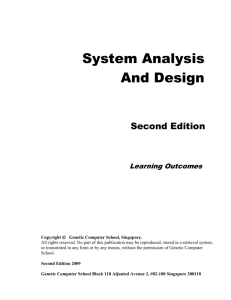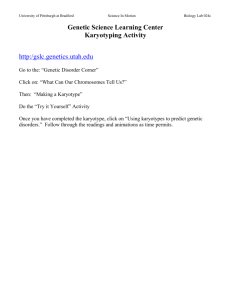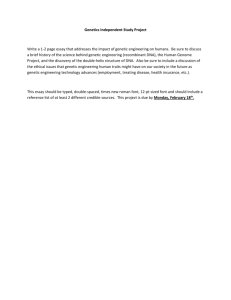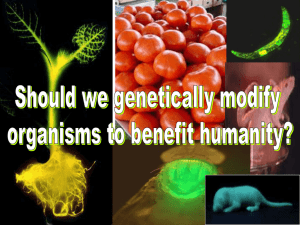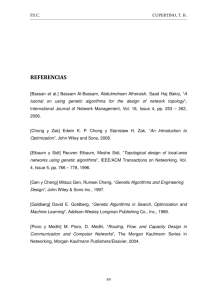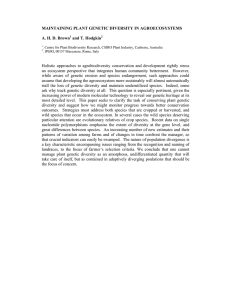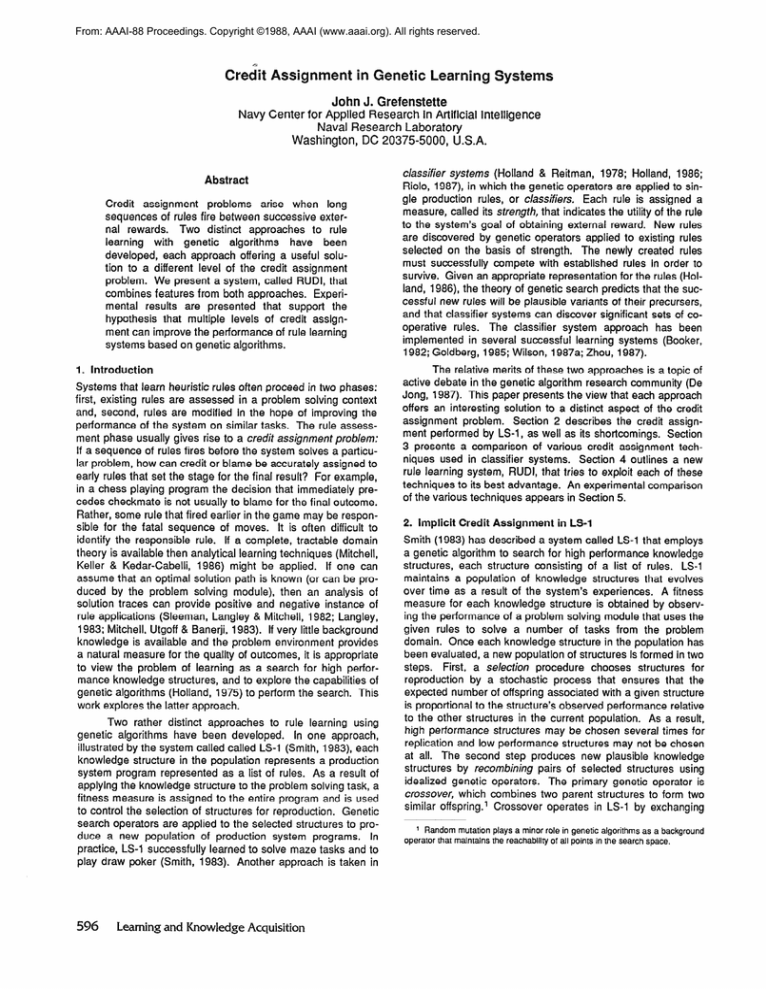
From: AAAI-88 Proceedings. Copyright ©1988, AAAI (www.aaai.org). All rights reserved.
Creiit
Assignment
in Genetic Learning Syste
John J. Grefenstette
Navy Center for Applied Research in Artificial Intelligence
Naval Research Laboratory
Washington, DC 203755000, U.S.A.
Abstract
Credit assignment
problems
arise when long
sequences of rules fire between successive external rewards.
Two distinct approaches
to rule
learning
with
genetic
algorithms
have
been
developed,
each approach offering a useful solution to a different level of the credit assignment
problem. We present a system, called RUDI, that
combines features from both approaches.
Experimental results are presented
that support the
hypothesis
that multiple levels of credit assignment can improve the performance of rule learning
systems based on genetic algorithms.
I.
Introduction
Systems that learn heuristic rules often proceed in two phases:
first, existing rules are assessed in a problem solving context
and, second, rules are modified in the hope of improving the
performance of the system on similar tasks. The rule assessment phase usually gives rise to a credit assignment problem:
If a sequence of rules fires before the system solves a particular problem, how can credit or blame be accurately assigned to
early rules that set the stage for the final result? For example,
in a chess playing program the decision that immediately precedes checkmate is not usually to blame for the final outcome.
Rather, some rule that fired earlier in the game may be responsible for the fatal sequence of moves.
It is often difficult to
identify the responsible
rule. If a complete, tractable domain
theory is available then analytical learning techniques (Mitchell,
Keller & Kedar-Cabelli,
1986) might be applied.
If one can
assume that an optimal solution path is known (or can be produced by the problem solving module), then an analysis of
solution traces can provide positive and negative instance of
rule applications (Sleeman, Langley & Mitchell, 1982; Langley,
1983; Mitchell, Utgoff & Banerji, 1983). If very little background
knowledge is available and the problem environment
provides
a natural measure for the quality of outcomes, it is appropriate
to view the problem of learning as a search for high performance knowledge structures, and to explore the capabilities of
genetic algorithms (Holland, 1975) to perform the search. This
work explores the latter approach.
Two rather distinct approaches
to rule learning using
genetic algorithms
have been developed.
In one approach,
illustrated by the system called called LS-1 (Smith, 1983), each
knowledge structure in the population represents a production
system program represented
as a list of rules. As a result of
applying the knowledge structure to the problem solving task, a
fitness measure is assigned to the entire program and is used
to control the selection of structures for reproduction.
Genetic
search operators are applied to the selected structures to produce a new population
of production
system programs.
In
practice, LS-1 successfully learned to solve maze tasks and to
play draw poker (Smith, 1983). Another approach is taken in
5%
Learning and Knowledge Acquisition
classifier systems (Holland & Reitman, 1978; Holland, 1986;
Riolo, 1987), in which the genetic operators are applied to single production
rules, or classifiers.
Each rule is assigned a
measure, called its strength, that indicates the utility of the rule
to the system’s goal of obtaining external reward. New rules
are discovered
by genetic operators applied to existing rules
selected on the basis of strength.
The newly created rules
must successfully
compete with established
rules in order to
survive. Given an appropriate representation for the rules (Holland, 1986), the theory of genetic search predicts that the successful new rules will be plausible variants of their precursers,
and that classifier systems can discover significant sets of cooperative
rules. The classifier system approach
has been
implemented
in several successful learning systems (Booker,
1982; Goldberg, 1985; Wilson, 1987a; Zhou, 1987).
The relative merits of these two approaches is a topic of
active debate in the genetic algorithm research community (De
Jong, 1987). This paper presents the view that each approach
offers an interesting solution to a distinct aspect of the credit
assignment
problem.
Section 2 describes the credit assignment performed by LS-1, as well as its shortcomings.
Section
3 presents a comparison
of various credit assignment techniques used in classifier systems.
Section 4 outlines a new
rule learning system, RUDI, that tries to exploit each of these
techniques to its best advantage.
An experimental comparison
of the various techniques appears in Section 5.
2. ImplicitCredit Assignment in LS-1
Smith (1983) has described a system called LS-1 that employs
a genetic algorithm to search for high performance knowledge
structures, each structure consisting of a list of rules. LS-1
maintains a population of knowledge
structures that evolves
over time as a result of the system’s experiences.
A fitness
measure for each knowledge structure is obtained by observing the performance of a problem solving module that uses the
given rules to solve a number of tasks from the problem
domain. Once each knowledge structure in the population has
been evaluated, a new population of structures is formed in two
steps.
First, a selection procedure
chooses structures for
reproduction
by a stochastic
process that ensures that the
expected number of offspring associated with a given structure
is proportional to the structure’s observed performance relative
to the other structures in the current population.
As a result,
high performance structures may be chosen several times for
replication and low performance structures may not be chosen
at all. The second step produces new plausible knowledge
structures by recombining
pairs of selected structures using
idealized genetic operators.
The primary genetic operator is
crossover, which combines two parent structures to form two
similar offspring. 1 Crossover operates in LS-1 by exchanging
l Random mutation plays a minor role in genetic algorithms as a background
operator that maintains the reachability of ail points in the search space.
of the parents.
segments of the string or list representations
For example, if the parents are represented by the lists:
(rule A, rule B, rule C, rule D, rule E) and
(rule a, rule b, rule c, rule d, rule e)
then crossover
at the rule level2 might produce the offspring
(rule A, rule B, rule c, rule d, rule e) and
(rule a, rule b, rule C, rule D, rule E)
The combined effect of performance-biased
reproduction
and
crossover is a sophisticated
form of adaptive search through
the space of knowledge structures described by the Schema
Theorem for genetic algorithms, established by Holland (1975)
and extended
to encompass
LS-l’s
operator set by Smith
(1983). This theorem states that the number of structures in
the knowledge base that share a given subset of components
(e.g., a group of rules in LS-1) can be expected to increase or
decrease over time at a rate proportional to the observed performance of the subset. This property is known as the implicit
parallelism of genetic algorithms (Holland, 1975). Thus, even
though LS-1 explicitly computes utility only for entire sets of
rules, credit assignment operates implicitly at the level of much
smaller groups of rules.
The implicit credit assignment
in LS-1 is especially
effective if related rules are clustered, since rules that are physically close together on the list representing
the knowledge
structure stand a good chance of being inherited as a group.
For this reason, LS-1 includes an inversion operator (Holland,
1975) that reverses a randomly chosen contiguous set of rules
on a given knowledge structure, thereby altering the rule combinations disrupted by crossover.
A moderate rate of inversion
produced
slight performance
improvements
in LS-1 (Smith,
1983). However,
it was found that random inversion is too
weak a method to search the space of rule permutations
and
identify related subsets of rules. The clustering problem was
a system
that
performs
partially
addressed
in LS-2,
classification
of human gait data (Schaffer & Grefenstette,
1985), by assigning multiple performance
measures for each
rule set. Section 4 presents a new way of using individual rule
utilities to cluster related sets of rules within the LS-1 framework. First, we describe how such rule utilities can be computed using techniques developed for classifier systems.
probability of a matched rule being selected to fire is proportional to its strength.3 When a rule fires, the operator specified
by the right-hand-side
is applied to the current state to produce
the new state. If no rule matches the current state, a randomly
chosen operator is used to produce the next state.
We first consider a strength updating scheme we call the
Profit Sharing Plan (PSP), a simplified version of the strength
updating scheme described by Holland and Reitman (1978). In
this scheme, problem solving is divided into episodes delimited
by the receipt of external reward. At the end of each episode,
the strength of each active rule loses a fixed faction of its value
and gains an amount equal to the reward obtained.4 Under
relatively consistent external rewards, the strength of each rule
under the PSP rapidly converges
to an equilibrium strength
that predicts the level of reward that will be received at the end
of the episode.
Most recent classifier systems (Booker, 1982; Goldberg,
1983; Riolo, 1987; Wilson, 1987a) have adopted a distributed,
incremental credit assignment scheme, called the Bucket Brigade Algorithm (BBA), that is closely related to the Temporal
Difference Methods analyzed by Sutton (1988). In its simplest
form, the BBA requires that each time a rule fires, the rule pays
a fixed fraction, called the bid-ratio, of its strength to the rule
that fired on the previous time step. When external reward is
obtained, it is paid to the final rule in the chain.
In many cases, the PSP and the BBA lead to identical
results, but differences can arise when rules match more than
one state. Consider the example shown in Figure 1. Assuming that state A arises equally as often as state E, Table 1
shows the equilibrium strength for the rules under each credit
assignment scheme. This example shows that rules that frequently fire in sequence are assigned similar levels of strength
by the BBA, whereas the PSP generally gives a better estimate
of the expected external reward.
Reward:
200
100
Fig. 1. State Space Fragment
3. Explicit Credit Assignment in Classifier Systems
A primary difference between LS-1 and classifier systems is
that classifier systems assign a utility measure called strength
to individual rules rather than to entire production system programs. Just as the genetic algorithm in LS-1 implicitly operates
on small groups of rules based on explicit fitness measures
assigned to entire rule sets, the genetic algorithm in classifier
systems implicitly exploits information
about components
of
rules based on the strength assigned to individual rules (Holland, 1986). Here we focus on the explicit credit assignment
mechanisms that operate on the rule level. We further limit the
discussion
to classifier systems that learn heuristic control
rules for applying a set of known operators to a set of states.
We assume that a single rules fires at each step, and that the
* Crossover in LS-1 operates at multiple levels. Crossover might occur
between individual symbols of two rules, producing new rules that inherit some
conditions from each parent (Smith, 1983).
Rule
PSP-Strength
BBA-Strength
Rl
R2
R3
R4
R
200
200
150
100
100
150
150
150
150
150
2
Table 1. Effects of Different Strength Updating Schemes
3 In the general classifier system model (Holland, 1986; Riolo, 1987) conflict
resolution may depend on the generality of the rules, strengths may be reduced
by a variety of taxes, and more than one rule may fire on a single step. The
effects of these factors on credit assignment is a topic for further research. The
conflict resolution methods we discuss bear some similarity to those in ACT
(Anderson 8 Kline, 1979).
4 Holland and Reitman (1978) attenuate rewards so that rules firing earlier
are usually rewarded less than those firing closer to the end of an episode.
Grefenstette
597
4. RUDI: A Multilevel Credit Assignment System
1)
We have seen that credit assignment in LS-1 operates on the
level of groups of rules, but is hampered
by its lack of
knowledge
about the performance
of individual rules and by
the inability of random inversion to create meaningful clusters
of rules. The PSP and the BBA provides complementary
utility
information
about individual rules. PSP-Strength
provides a
more accurate estimate of the utility of a rule in terms of its
expected
external
reward.
BBA-Strength
indicates
the
dynamic
associations
among rules, with rules that fire in
sequence converging
to similar levels of BBA-Strength.
This
section describes one way to exploit all of these credit assignment techniques in a single system.
4.1. The Problem Solving Level
RUDI (for Rule Dlscovery) is a system that combines
of LS-1 and classifier systems, as shown in Figure 2.
features
Sort the rules within the knowledge
basis of their BBA-Strength.
on the
Treating the knowledge
structure as a ring, shift the
sorted rules a random number of rule positions along the
structure.
The shift phase is necessary in order to avoid a bias against
certain distributions of building blocks. For example, the shift
phase allows (but does not guarantee) an offspring to inherit all
of the high BBA-Strength
rules from each parent.
Figure 3
shows an example of clustering a rule set.
BEFORE CLUSTERING:
Rule:
R,
Strength:
225
R2
50
R3
250
R.9
30
R5
300
R3
250
Rl
225
R2
50
R4
30
R5
300
R3
250
Rl
225
R2
50
1) SORT BY BBA-STRENGTH:
Rule:
Performance
structure
Strength:
R5
300
>
2) CIRCULAR SHIFT:
/I
( Strength
1 Reward
Rule:
Strength:
R4
30
Fig. 3. Cluster Operator.
Fig. 2. RUDI: A Multilevel Genetic Learning System.
The problem solving level of RUDI consists of a simplified
classifier system, as described
in Section 3, that maintains
both PSP-Strength
and BBA-Strength
for each rule. Since
PSP-Strength
provides
an estimate
of expected
external
reward, it is used for conflict resolution during problem solving.
BBA-Strength
is used by the learning level to cluster cooperative
sets of rules, as described
below.
The problem
solver reports to the learning level the average external reward
received by each rule set during the solution of a sets of tasks
from the problem
domain,
as well as the updated
rule
strengths.
4.2. The Learning Level
Like LS-1, the genetic learning algorithm in RUDI operates on
a population of knowledge structures, each represented by a
list of rules. The overall performance
of the knowledge structures controls the selection of knowledge structures for reproduction. Modified structures are formed by applying crossover
to the selected structures, as in LS-1, except that each rule in
the offspring
inherits
the strengths
associated
with the
corresponding
rule in the parent structure.!j
Unlike
LS-1, the strengths
of the individual
rules
influence the physical representation
of the knowledge structures in RUDI, making it more likely that useful combinations of
rules survive and propagate throughout
the knowledge base.
This is accomplished
by a heuristic form of inversion called
clustering.
Clustering is performed just prior to crossover and
involves two steps:
5 In the case of a new rule created by crossing in the middle of two rules, the
new rule is assigned the average strength of the two parental rules.
598
Learning
and Knowledge
Acquisition
As shown in Section 3, rules that frequently occur in the same
problem solving chain will tend to have similar levels of BBAStrength.
Clustering moves such rules closer together on the
knowledge
structure,
and since crossover takes contiguous
groups of rules from each parent, rules occurring frequently in
the same chain will tend to be inherited as a group.
This
heuristic provides a way to form meaningful clusters of cooperative rules that was missing from LS-1.
5. An Experimental Study
This section describes experiments that compare RUDl’s combination of credit assignment mechanisms with those mechanisms in isolation. Space permits the detailed discussion of only
one set of experiments, but similar results have been achieved
on other problems with various state-space topologies and distributions of rewards to final states. The test problem consisted
of a state space containing 288 states as shown in Figure 4.
There were 32 initial states and each traversal of the space
required
eight decision
steps.
Each non-final
state was
identified by an 8-bit feature vector indicating its position in the
space. Three operators -- left, straight, and right -mapped each state to its successors.
The state space was
cylindrical, so that left(O) = 63. The rewards associated with
the final states ranged from 0 to 1000, with an average of 250.
As shown in Table 2, the rewards were distributed around two
hills of high reward, with payoff valleys between. The distribution of external rewards to the final states was chosen in order
to require the discovery of correct heuristic rules for the early
stages of each task in order to gain maximum reward.
For
example, to obtain maximum reward from starting state 0 (at
the upper left corner of the state space), it was necessary to
right for at least seven of the eight steps
apply the operator
in the task (in order to reach maximum reward at state 263 or
264).
duction. The system using PSP clearly dominated the system
using BBA, but both left much room for improvement, since the
maximum reward per episode was 1000. These results, while
not conclusive,
are consistent with previous studies in which
classifier systems have had difficulty in performing successful
credit assignment over chains of similar length, unless the BBA
is augmented
by specially designed bric!ge classifiers (Riolo,
1987).
INITIAL STATES
30
31
62
63
8
lOOOAve
800 -
PSP
BBA
____cvv
FINAL STATES
Fig. 4. Experimental State Space
I State:
256
258
0
0
50
272
273
274
0
0
50
Reward:
State:
257
Reward:
259
260
281
282
263
264
265 266
267
268
500
1000
1000
500
250
125
75
277
278
279
280
281
282
283
284
75 125 250
500
1000
1000
500
250
125
75
75 125 250
275
276
269 270
50
0
2711
50
0
I
I
I
I
I
I
0
10
20
30
40
50
Episodes (K)
0
285 286 287
0
Random
Fig. 5. Performance Profiles of Classifier Systems.
Table 2. Distribution of External Rewards.
5.1. Rule Representation
The left hand side of each rule contains a pattern that matches
a set of states, using the symbol # to indicate that the value of
the corresponding
feature is irrelevant.6 The right hand side of
each rule specifies a single operator, using a fixed mapping
from integers to operators.
For example, the rule
00000##1
represents
-+ 0010
-
I
I
I
I
I
I
0
10
20
30
40
50
Episodes (K)
the heuristic
IF the current state is in the set {1,3,
THEN apply operator go-straight.
. . ..a*..
.
5, 7)
Given this representation,
there are a total of 19,683 distinct
rules in the rule space. Recognizing that it is generally infeasible to consider all possible rules (or even all maximally specific
rules), each system was required to learn rule sets that contained a maximum of 128 rules.
5.2. Experimental Results
A series of experiments
was performed to test the effects of
various
credit assignment
methods
on the test problem.
Although
it is possible to inject available
knowledge
into
genetic learning systems (Grefenstette,
1987), for the purposes
of these experiments,
all the learning systems began with randomly generated knowledge structures.
Since genetic learning
systems are stochastic processes, all plots show the average
of five independent runs.
Figure 5 shows performance
profiles for a random walk
algorithm and for two simple classifier systems that used either
the PSP or the BBA for conflict resolution and for rule repro-
Fig. 6. Performance Profiles of IS-1 Style Systems.
Figure 6 shows the performance of three LS-1 style systems that used different forms of credit assignment.
The system denoted LS-1.0 used random conflict resolution and no
clustering at the learning level. The system denoted LS-1.5
used PSP for conflict resolution, but performed no clustering at
the learning level. And, as described above, RUDI used PSPStrength for conflict resolution and BBA-Strength
for clustering
at the learning level. Each system maintained a knowledge
base of 50 knowledge structures, each consisting of 64 rules
along with their associated
strengths.
Each structure was
evaluated in 20 reward episodes, each starting at a randomly
chosen initial state.
Each run consisted
of 2500 rule set
evaluations (50 generations).
After each run, the rule set with the highest evaluation in
the final population was subjected to a final evaluation consisting of 1000 reward episodes.
The average results for all runs
are shown in Table 3. The clear performance
advantage of
RUDI over the other systems supports the hypothesis that multiple levels of credit assignment can improve the performance
of rule discovery systems based on genetic algorithms.
s Holland (1975) discusses the possibility of learning new features, but we do
not pursue that approach here. Holland (1986) discusses appropriate pattern
languages for classifier systems, and Booker (1982) discusses issues in
matching.
Grefenstette
599
System
Optimal
Ave. External
rithms and simulated
Pitman Press.
Reward
943
LS-1.5
791
LS-1 .o
724
PSP
632
BBA
468
Random
250
Holland J. H. (1986). Escaping brittleness: The possibilities of
general-purpose
learning algorithms applied to parallel
rule-based systems.
In R.S. Michalski, J. G. Carbonell,
& T. M. Mitchell (Eds.), Machine learning: An artificial
intelligence approach (Vol. 2). Los Altos, CA: Morgan
Kaufmann.
Table 3. Performance of Final Rule Sets.
6. Conclusions
This paper has examined issues of credit assignment in rule
learning systems based on genetic algorithms.
The classifier
systems approach and the LS-1 approach each provides useful
mechanisms
for assigning
credit.
RUDI represents
a new
method of reconciling these two approaches,
using the BBA
designed for classifier systems to solve the clustering problem
in LS-1. RUDI demonstrate
the benefits of exploiting multiple
levels of credit assignment.
Further testing is needed to delimit
the class of problems for which this approach is most valuable.
An important topics for further research involves the
development
of local strength updating schemes like the BBA
that predict levels of external reward to the degree achieved by
the PSP scheme. Such schemes would be especially useful in
systems that allow parallel rule firing (Holland, 1986).
Wilson (1987b) has described
a hierarchical
form of
classifier system in which strength
is passed only among
modules that operate at the same level of abstraction,
thus
keeping the chains at each level relatively short. This seems to
be a promising approach that deserves further attention.
Acknowledgments
I want to thank Lashon Booker and Ken De Jong
stimulating discussions on this topic.
for many
References
Anderson, J. R., & Kline, P. J. (1979). A learning system and
its psychological
implications.
Proceedings
of the Sixth
International
Joint Conference
on Artificial Intelligence
(pp. 16-21). Tokyo: Morgan Kaufmann.
Booker, L. 6. (1982). Intelligent behavior as as adaptation to
the task environment.
Doctoral dissertation, Department
of Computer and Communications
Sciences, University
of Michigan, Ann Arbor.
Holland, J. H., & Reitman, J. S. (1978). Cognitive systems
based on adaptive algorithms.
In D. A. Waterman, & F.
Hayes-Roth
(Eds.), Pattern-directed
inference systems.
New York: Academic Press.
Langley,
P. (1983).
Learning
effective
search heuristics.
Proceedings of the Eighth International Joint Conference
on Artificial Intelligence
(pp. 419421).
Karlsruhe, Germany: Morgan Kaufmann.
Mitchell, T. M., Keller, R. M., & Kedar-Cabelli,
S. T.
Explanation-based
generalization:
A unifying
Machine Learning, I (I), 47-80.
Riolo,
R. L. (1987).
Bucket brigade performance
I: Long
sequences
of classifiers.
Proceedings
of the Second
International
Conference
on Genetic Algorithms
and
Their Applications
(pp. 184-l 95).
Cambridge,
MA:
Lawrence Erlbaum.
Schaffer, J. D., & Grefenstette,
J. J. (1985).
Multi-objective
learning via genetic algorithms.
Proceedings
of the
Ninth International
Joint Conference
on Artificial Intelligence (pp. 593-595).
Los Angeles, CA: Morgan Kaufmann.
Sleeman, D., Langley, P., & Mitchell, T. M. (1982). Learning
from solution paths: An approach to the credit assignment problem. Al Magazine, Spring 1982, 48-52.
Smith,
S. F. (1983).
Flexible learning of problem solving
heuristics through adaptive search.
Proceedings of the
Eighth International Joint Conference on Artificial Intelligence
(pp. 422-425).
Karlsruhe,
Germany:
Morgan
Kaufmann.
Sutton,
R. S. (1988). Learning to predict by the methods of
temporal differences.
(Technical Report TR87-509.1).
Waltham, MA: GTE Laboratories Inc.
Wilson, S. W.
problem.
Goldberg, D. E. (1985).
Dynamic system control using rule
learning and genetic algorithms.
Proceedings
of the
Ninth International
Joint Conference on Artificial Intelligence (pp. 588-5925).
Los Angeles, CA: Morgan Kaufmann.
Zhou,
600
problem specific
In Genetic a/go-
Learning and Knowledge Acquisition
(1986)
view.
Mitchell, T. M., Utgoff, P. E., & Banerji, R. (1983). Learning by
experimentation:
Acquiring and refining problem-solving
heuristics.
In R.S. Michalski, J. G. Carbonell, & T. M.
Mitchell (Eds.), Machine /earning: An artificial intelligence
approach (Vol. 1). Palo Alto, CA: Tioga.
De Jong, K. A. (1987). On using genetic algorithms to search
program spaces.
Proceedings
of the Second International Conference Genetic Algorithms and Their Applications (pp. 210-216).
Cambridge,
MA: Lawrence
Erlbaum.
Grefenstette,
J. J. (1987).
Incorporating
knowledge
into genetic algorithms.
D. Davis (ed.), London:
Holland, J. H. (1975). Adaptation in natural and artificial systems. Ann Arbor, Ml: University of Michigan Press.
1000
RUDI
annealing.
(1987a).
Classifier systems and the animat
Machine Learning, 3(Z), 199228.
Wilson, S. W. (1987b).
Hierarchical
credit allocation in a
classifier system.
In L. Davis (Ed.), Genetic algorithms
and simulated annealing.
London, UK: Pitman.
H. H. (1987).
CSM: A genetic classifier system with
memory for /earning by analogy.
Doctoral dissertation,
Department of Computer Science, Vanderbilt University,
Nashville.


